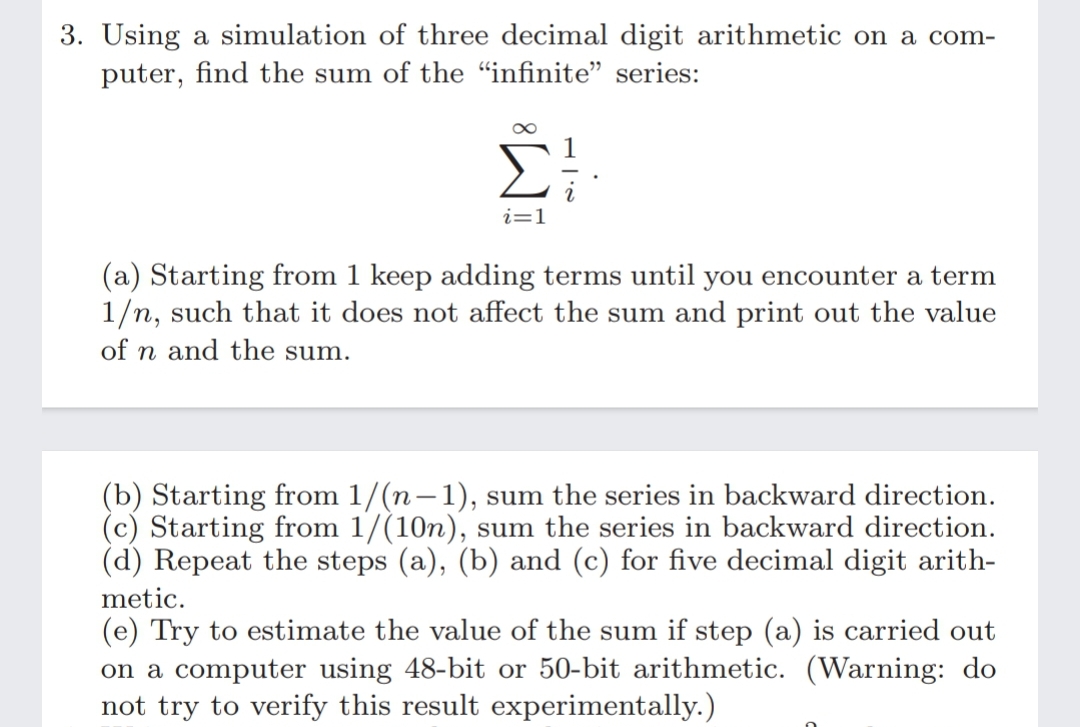3. Using a simulation of three decimal digit arithmetic on a com- puter, find the sum of the "infinite" series: i=1 (a) Starting from 1 keep adding terms until you encounter a term 1/n, such that it does not affect the sum and print out the value of n and the sum. (b) Starting from 1/(n–1), sum the series in backward direction. (c) Starting from 1/(10n), sum the series in backward direction. (d) Repeat the steps (a), (b) and (c) for five decimal digit arith- metic. (e) Try to estimate the value of the sum if step (a) is carried out on a computer using 48-bit or 50-bit arithmetic. (Warning: do not try to verify this result experimentally.)
3. Using a simulation of three decimal digit arithmetic on a com- puter, find the sum of the "infinite" series: i=1 (a) Starting from 1 keep adding terms until you encounter a term 1/n, such that it does not affect the sum and print out the value of n and the sum. (b) Starting from 1/(n–1), sum the series in backward direction. (c) Starting from 1/(10n), sum the series in backward direction. (d) Repeat the steps (a), (b) and (c) for five decimal digit arith- metic. (e) Try to estimate the value of the sum if step (a) is carried out on a computer using 48-bit or 50-bit arithmetic. (Warning: do not try to verify this result experimentally.)
Computer Networking: A Top-Down Approach (7th Edition)
7th Edition
ISBN:9780133594140
Author:James Kurose, Keith Ross
Publisher:James Kurose, Keith Ross
Chapter1: Computer Networks And The Internet
Section: Chapter Questions
Problem R1RQ: What is the difference between a host and an end system? List several different types of end...
Related questions
Question
Please write code in c++ . Please follow the instructions given in question. Do the part d) and e) . Parts a b c are done in one question here.

Transcribed Image Text:3. Using a simulation of three decimal digit arithmetic on a com-
puter, find the sum of the "infinite" series:
i=1
(a) Starting from 1 keep adding terms until you encounter a term
1/n, such that it does not affect the sum and print out the value
of n and the sum.
(b) Starting from 1/(n-1), sum the series in backward direction.
(c) Starting from 1/(10n), sum the series in backward direction.
(d) Repeat the steps (a), (b) and (c) for five decimal digit arith-
metic.
(e) Try to estimate the value of the sum if step (a) is carried out
on a computer using 48-bit or 50-bit arithmetic. (Warning: do
not try to verify this result experimentally.)
Expert Solution
This question has been solved!
Explore an expertly crafted, step-by-step solution for a thorough understanding of key concepts.
Step by step
Solved in 3 steps with 1 images

Recommended textbooks for you

Computer Networking: A Top-Down Approach (7th Edi…
Computer Engineering
ISBN:
9780133594140
Author:
James Kurose, Keith Ross
Publisher:
PEARSON

Computer Organization and Design MIPS Edition, Fi…
Computer Engineering
ISBN:
9780124077263
Author:
David A. Patterson, John L. Hennessy
Publisher:
Elsevier Science

Network+ Guide to Networks (MindTap Course List)
Computer Engineering
ISBN:
9781337569330
Author:
Jill West, Tamara Dean, Jean Andrews
Publisher:
Cengage Learning

Computer Networking: A Top-Down Approach (7th Edi…
Computer Engineering
ISBN:
9780133594140
Author:
James Kurose, Keith Ross
Publisher:
PEARSON

Computer Organization and Design MIPS Edition, Fi…
Computer Engineering
ISBN:
9780124077263
Author:
David A. Patterson, John L. Hennessy
Publisher:
Elsevier Science

Network+ Guide to Networks (MindTap Course List)
Computer Engineering
ISBN:
9781337569330
Author:
Jill West, Tamara Dean, Jean Andrews
Publisher:
Cengage Learning

Concepts of Database Management
Computer Engineering
ISBN:
9781337093422
Author:
Joy L. Starks, Philip J. Pratt, Mary Z. Last
Publisher:
Cengage Learning

Prelude to Programming
Computer Engineering
ISBN:
9780133750423
Author:
VENIT, Stewart
Publisher:
Pearson Education

Sc Business Data Communications and Networking, T…
Computer Engineering
ISBN:
9781119368830
Author:
FITZGERALD
Publisher:
WILEY